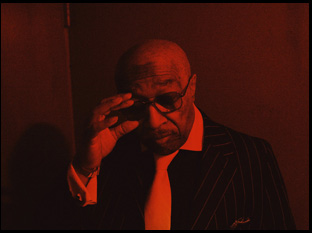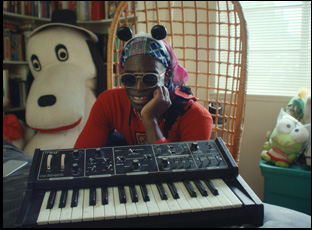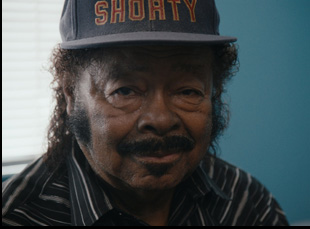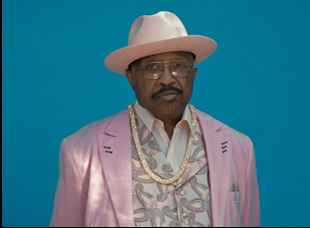From the outside, there wouldn’t seem to be anything too exciting going on in the home of Jerry Williams Jr., better known to music fans as Swamp Dogg, looking like any other middle-class residence in the San Fernando Valley. (Then again, as friends of the musician note, not much has changed since the days of “Boogie Nights” in the area when they suspect adult films are still being made left and right to Swamp Dogg’s surprise.) However, in “Swamp Dogg Gets His Pool Painted,” the suburban home is revealed to be a wonderland as the bon vivant has opened his doors to longtime collaborators Moogstar and Guitar Shorty, who are apt to jam out when a bedroom has been converted into a studio and if the mood strikes, they can turn it into a music video with a green screen on the premises. It actually alarms the owner when things are too quiet in the neighborhood and as someone with writing and producing credits on hundreds of albums beyond the dozens of his own as a solo recording artist, there always is the inclination to make some noise, whether with instruments or the many guests who just want to stop by and chat.
When Isaac Gale and Ryan Olson knew Swamp Dogg to be a bit of an extrovert from working with him in various capacities over the years, they couldn’t allow the magic to be kept exclusively inside the walls of the house. Long a cult figure in music circles who rose from writing hit singles in the 1960s for the likes of Gene Pitney and Patti LaBelle to bringing in Jenny Lewis in the present day to duet on a folk gospel album, with a highly lucrative excursion into producing a Beatles cover album performed by barking dogs, Swamp Dogg has the kind of career that’s bound to be overlooked by the mainstream when it’s difficult to quantify. Refreshingly, Gale and Olson don’t try to contain it, instead allowing Swamp Dogg to let loose in poolside chats with visitors ranging from Johnny Knoxville and Mike Judge and take inspiration from the creativity of their subject by involving him in cooking show segments and animated sequences that reflect his shape-shifting as an artist who first broke free of working exclusively in any one particular genre and then rethought how he’d engage with the industry, becoming a savvy marketer and owner of his own work.
As Gale and Olson let the stories behind the music flow like songs, attuned to Swamp Dogg’s own keen sense of tempo and hooks, “Swamp Dogg Gets His Pool Painted” bursts with love for a one-of-a-kind character who always strives to have a good time, and even as it shows him remembering his late wife Yvonne, who he credits with “mapping out most of the amazing things I did,” and deals with other loss as he makes it to his eighties, the film celebrates someone who constantly dares to do things differently and with his own notion of paradise has created one for himself with the community he’s built up around him. With the film now arriving in theaters after a premiere at SXSW last year, Gale and Olson are inviting everyone to join the party and recently the two graciously spoke about how they could infuse a life story such vitality, drawing on their musical backgrounds to find a rhythm and giving Swamp Dogg some much deserved time in the spotlight.

Isaac Gale: Yeah, we’re in our eighth year dealing with it. It started a couple years even before that. Ryan was producing an album for Swamp Dogg and then Ryan and I make music together, so I went out to Swamp Dogg’s house with Ryan and our friend David McMurry to shoot a music video and we got to meet the housemates and we just didn’t want to leave.
While we were shooting the music video, we just [thought], this house needs no art direction. [Swamp Dogg] has a light-up bed. He’s just walking around wearing a kimono. And during that shoot, he was looking down in his pool and he asked us if we knew anyone who painted pools. And we didn’t, but we knew a painter. So it all just jump-started from there. His house has this magical aura vibe going on. People coming through, making music, and it’s like a bright shining star sucking you in.
It hits a bunch of beats you’d see in a traditional biopic, but all in a very unexpected and casual way where there are no typical sit-down interviews, but conversations amongst friends. What was it like to go about this?
Isaac Gale: It was extremely casual. Those guys are very open. We didn’t really tell them to do anything. We tried to get them to wear the same clothes a few days in a row, just to have some continuity and the same coffee cup sometimes, but mostly those guys are just open. They’ll talk to anybody. Everyone who came through were friends of theirs or fans that we could get ahold of and we didn’t press the issue in terms of trying to force people that they don’t know to talk to them. We just threw them out there with hardly any prompting and we’d just record and see where the conversations went.
Ryan Olson: Yeah, we did absolutely no research for this at all. We learned about Swamp as we went along.
When you really have that experience of Swamp Dogg instead of following some more chronological timeline in the film, what was it that you could hold onto yourselves as far as telling his story?
Isaac Gale: The house was our main anchor point, so we could always come back there and see what’s going on if a story hits its end. We could go off in time in different branches We can meet Guitar Shorty and Moogstar and hear a little bit about them and the house’s orbit always was our focus and we could time travel in that way through all their stories.

Isaac Gale: Every time Swamp talked, it was probably much brought out in a direction.
Ryan Olson: Yeah, you ask him about one thing and he goes off in a different tangent and it’s like a more interesting story or it’s funnier. He’s always setting you up for a punchline about 10 minutes down the road and we learned to anticipate that coming. You start to learn their cadences, so you anticipate where they’re going, but we were always surprised.
Isaac Gale: Somehow Richard Branson came up, [like I asked at some point] “Did you meet Richard Branson?” We were talking about billionaires and that went into, “Yeah, I was signed to Virgin Records and then I got circumcised after that…”
Ryan Olson: The same day. And he’s so open, he’d let us use anything. He was happy to tell us whatever weird story, no matter how disgusting.
Isaac Gale: I kept some of those stories out, but the crazy thing is he actually had footage of that day of him getting signed and waddling around ’cause he just freshly got circumcised.
In general, was it a challenge to visually represent some of these old stories? You’ve got some great archival as well as animation to accompany Moogstar’s adventures.
Isaac Gale: It wasn’t really difficult. It was more just really fun. A couple of years in, Swamp pulled out this giant tub of photos and archival material from under his bed, and then showed us this closet full of videotapes, so we just started digging through that stuff. With Moogstar, he told us the story of him and the owl and the Evel Knievel suit over and over, and we sort of understood it, but it wasn’t until we started animating it like a Scooby-Doo cartoon, that we really could find the path of what the story meant.
Ryan Olson: Also finding the actual photographs from that night.
Isaac Gale: And Les Blank’s son Harrod is the one who took Moogstar to Evel Knievel’s grave, and took those photos of him in the suit — and the video of the naked woman in the fountain at McDonald’s. All that’s real. So once we got that, it just opens up a whole new world.
That’s wild that there’s a Les Blank connection, given his documentary work.
Isaac Gale: Yeah, have you seen “A Poem as a Naked Person”? Once we got into editing, we were looking for inspirational films to watch before we started, and that was one of the first ones we watched. We didn’t realize how many crazy cosmic connections there were, [but that film] starts with a pool being painted. And they filmed a bunch of it in Sound Emporium, the same studio that we filmed Swamp in Nashville…
Ryan Olson: [Playing with] John Prine.
Isaac Gale: John Prine’s in the shot, just in the background. It was so cool to find all these things.
It moves so fluidly. What was it like finding the right rhythm for this?
Isaac Gale: We’re both musicians. Ryan worked on the score part of it with a bunch of different musicians, and that part was really fun, finding needle drops from all [Swamp Dogg’s] music to put in there. We edited for about a year-and-a-half, and we were lucky enough to have time to find that in the edit. Our original cut was two hours and now it’s 93 minutes, so we didn’t cut all that much out of it, but we wanted to cram so many stories in. Some of them, unfortunately, are gone, but we found the right pace. And you can make more movies about these guys because they have so many amazing, funny stories, but everything was [geared] towards a certain flow and timing and cadence that just fit those guys so well.

Ryan Olson: A lot of the score is based on progressions from Swamp’s songs that we just tweaked in certain ways. Then just going down to Nashville, we did a session with him, Tyler, and Luke, and Jeremy, and it was a trio of pedal steel and guitar and organ and did renditions of the song with that, but then just create vibes in general. Swamp is really fun to work with and we’d made three albums together, so it didn’t feel like it was like overstepping by trying to write music for his story.
Isaac Gale: Yeah, maybe other filmmakers are good friends and collaborators with their subjects, but that really went so far for us in this project, with them being open with us and understanding what we’re doing and us trying to understand what they’re doing.
That really comes across in how adventurous the film gets. When the idea of having a cooking show segment comes into play, what’s the discussion around that like?
Isaac Gale: That’s something we uncovered when he showed us his archival materials. He had like a five-page snippet of a cookbook that he’d started writing in the ’70s that he never published. It’s not as much in the movie as we had thought [because] Swamp used to love cooking, and when his wife Yvonne passed away, he stopped all that. So we were trying to use cooking show as a way to get him reanimated about cooking, and instead it became more about like Swamp’s insane creativity, like this amazing prolific musician who wrote a cookbook and [the book] has amazing stories from his life.
We are buddies with people at Pioneer Works, and pitched it to them and they have a publishing wing, so they’re like, “Yeah, let’s do this,” and we have friends that work at Zero Space in New York that could help us build a kitchen that looked like his ’70s kitchen with crazy speakers and strobe lights. Eventually, there’ll be a full episode of this cooking show for the book, [which] comes out a couple weeks after the film’s premiere.
How fun is that?
Ryan Olson: And if you call that phone number in the movie, it’s a real [number], you can order that book.
Isaac Gale: The other feature of the cooking we noticed when we were talking to Swamp is he mentioned how important cooking was for him to ground himself during anxiety and his depression years. It goes back to how he was raised with his aunts, in the kitchen cooking all the time. And I [thought], that’s his place where he can just get a grip on things. And Johnny Knoxville asked him, he was like, “Hey, does music help calm you down?” And he’s like, “No, it’s not that.” It’s cooking that he needed to center himself. It’s vague in the film, but that’s the point of [that conversation].

Isaac Gale: Finding good needle drops was a really fun time. We found this song, “I Kissed Your Face.” It’s just in the middle of one of his albums, and there’s this lyric he repeats, ”All of this reminded me of you.” And [having that song at] the end of his 80th birthday party with that refrain over and over just had so much meaning. Stuff like that was really great. I don’t know that we had any trouble putting too many things together, except the swimming pool itself. Someone ruined it the first time, so it took us like three more years to paint it again. That was our biggest challenge probably.
Ryan Olson: That’s why it’s a poorly painted pool.
Isaac Gale: That’s why our company is called Poorly Painted Pools. [laughs]
The end result looks pretty amazing. What’s it been like to travel with the film and getting it out there?
Ryan Olson: Yeah, it’s wild. I have no expectations and it’s nice to have it out there. I’ve only heard horror stories about people spending just as long on their projects or films that have been shelved because of whatever legal entanglements or fuckery that goes on, and I make music mainly, so if I put this much work into an album that didn’t come out [as I did this movie], someone would pay the price. So I’m very grateful that this is coming out, and Magnolia is one of my favorite district film companies out there, so it’s really an honor.
Isaac Gale: It’s super fun. We did about a year of going to film fests and we’re really psyched to have Magnolia take control a little bit and getting it to theaters. I still feel like some world disaster will happen and this movie actually won’t premiere next week, but so far so good.
“Swamp Dogg Gets His Pool Painted” opens on May 2nd in theaters, including the NuArt in Los Angeles and the IFC Center in New York. A full list of theaters and cities is here.




